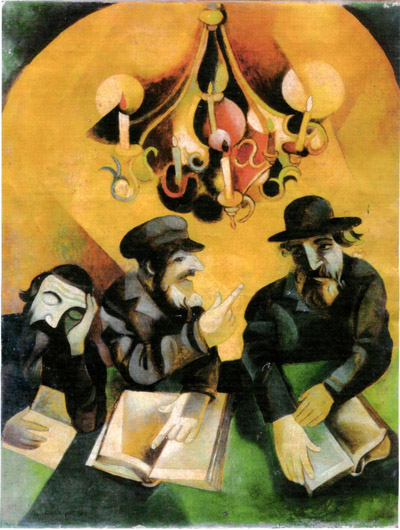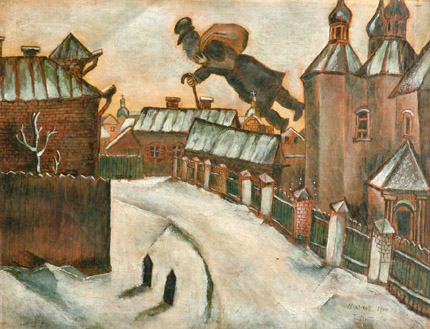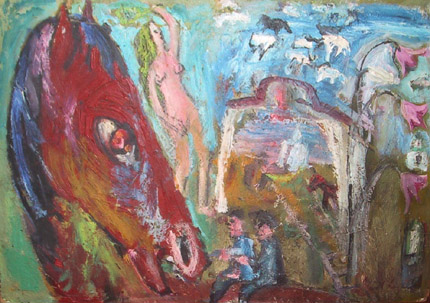 home
about
artists
exhibitions press
contact
purchase
home
about
artists
exhibitions press
contact
purchase |
|
|
|
MARC CHAGALL (1887-1985) Marc Zaharovich Chagall (6 July 1887 - 28 March 1985) was a Russian artist associated with several major artistic styles and one of the most successful artists of the 20th century. He was an early modernist, and created works in virtually every artistic medium, including painting, book illustrations, stained glass, stage sets, ceramic, tapestries and fine art prints. Marc Chagall, born Moishe Segal, was born in a Lithuanian Jewish family in Liozna, near the city of Vitebsk (Belarus, then part of the Russian Empire) in 1887. At the time of his birth, Vitebsk's population was about 66,000, with half the population being Jewish. A picturesque city of churches and synagogues, it was called "Russian Toledo", after a cosmopolitan city of the former Spanish Empire. As the city was built mostly of wood, little of it survived years of occupation and destruction during World War II. Chagall was the youngest of six children. The family name, Shagal, is a variant of the name Segal, which in a Jewish community was usually borne by a Levitic family. In Russia at that time, Jewish children were not allowed to attend regular Russian schools or universities. Their movement within the city was also restricted. Chagall therefore received his primary education at the local Jewish religious school, where he studied Hebrew and the Bible. At the age of 13, his mother tried to enroll him in a Russian high school, and he recalled, "But in that school, they don't take Jews. Without a moment's hesitation, my courageous mother walks up to a professor." She offered the headmaster 50 roubles to let him attend, which he accepted. In 1906, he moved to St. Petersburg which was then the capital of Russia and the centre of the country's artistic life with its famous art schools. Since Jews were not permitted into the city without an internal passport, he managed to get a temporary passport from a friend. He enrolled in a prestigious art school and studied there for two years. By 1907, he had begun painting naturalistic self-portraits and landscapes. Between 1908 to 1910, Chagall was a student of Léon Bakst at the Zvantseva School of Drawing and Painting. While in St. Petersburg, he discovered experimental theater and the work of such artists as Paul Gauguin. Bakst, also Jewish, was a designer of decorative art and was famous as a draftsman designer of stage sets and costumes for the 'Ballets Russes,' and helped Chagall by acting as a role model for Jewish success. Bakst moved to Paris a year later. Art historian Raymond Cogniat writes that after living and studying art on his own for four years, "Chagall entered into the mainstream of contemporary art. ...His apprenticeship over, Russia had played a memorable initial role in his life. Art critic Robert Hughes referred to Chagall as "the quintessential Jewish artist of the twentieth century". According to art historian Michael J. Lewis, Chagall was considered to be "the last survivor of the first generation of European modernists". For decades, he "had also been respected as the world's preeminent Jewish artist". Using the medium of stained glass, he produced windows for the cathedrals of Reims and Metz, windows for the UN, and the Jerusalem Windows in Israel. He also did large-scale paintings, including part of the ceiling of the Paris Opéra. Before World War I, he traveled between St. Petersburg, Paris, and Berlin. During this period he created his own mixture and style of modern art based on his idea of Eastern European Jewish folk culture. He spent the wartime years in Soviet Belarus, becoming one of the country's most distinguished artists and a member of the modernist avante-garde, founding the Vitebsk Arts College before leaving again for Paris in 1922. He had two basic reputations, writes Lewis: as a pioneer of modernism and as a major Jewish artist. He experienced modernism's "golden age" in Paris, where "he synthesized the art forms of Cubism, Symbolism, and Fauvism, and the influence of Fauvism gave rise to Surrealism". Yet throughout these phases of his style "he remained most emphatically a Jewish artist, whose work was one long dreamy reverie of life in his native village of Vitebsk." "When Matisse dies," Pablo Picasso remarked in the 1950s, "Chagall will be the only painter left who understands what colour really is" Author Serena Davies writes that "By the time he died in France in 1985—the last surviving master of European modernism, outliving Joan Miró by two years—he had experienced at first hand the high hopes and crushing disappointments of the Russian revolution, and had witnessed the end of the Pale, the near annihilation of European Jewry, and the obliteration of Vitebsk, his home town, where only 118 of a population of 240,000 survived the Second World War." From Wikipedia |
|
|
E-mail: info@hayhillgallery.com |


